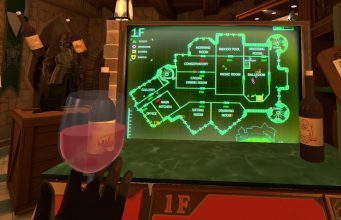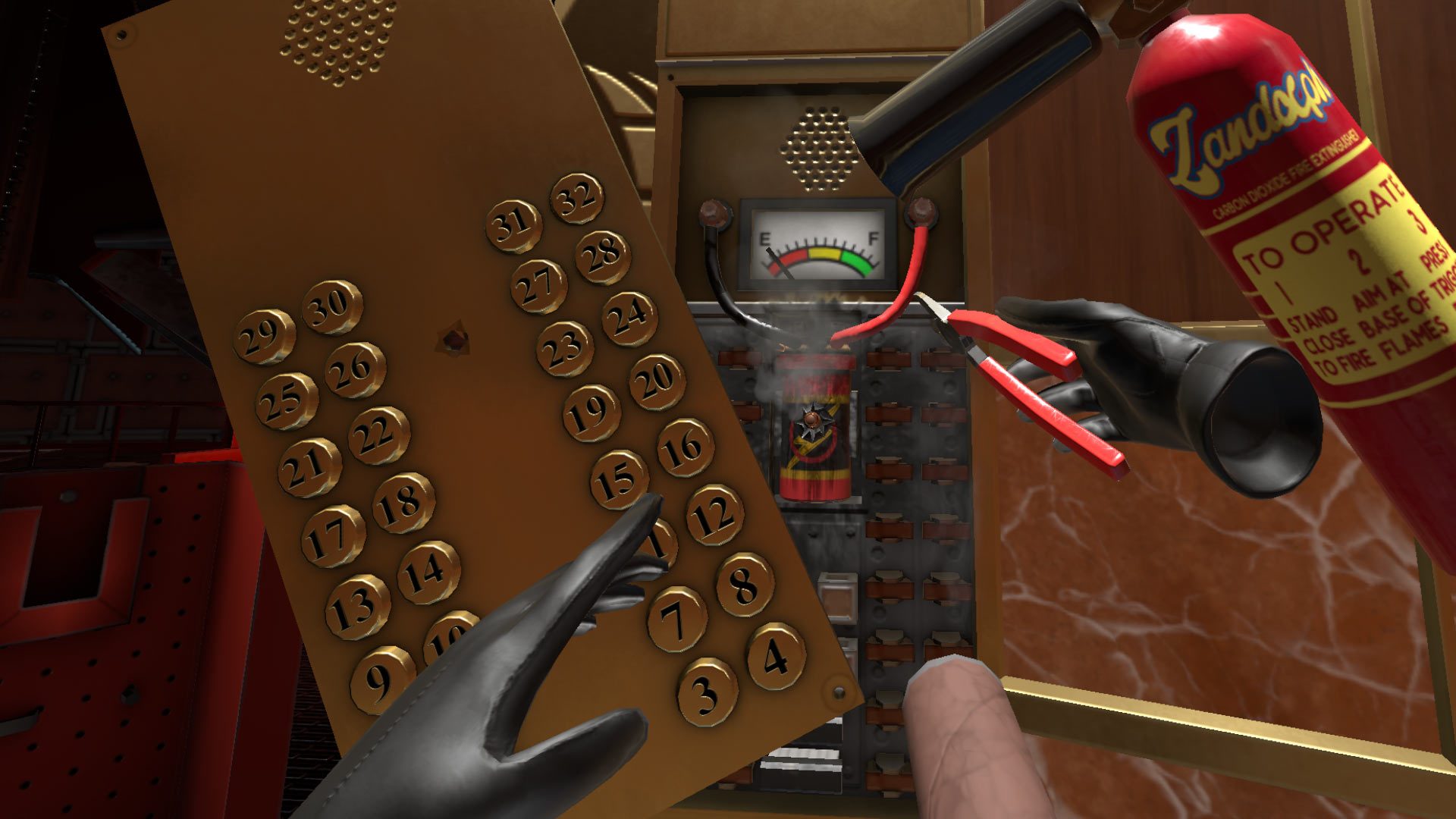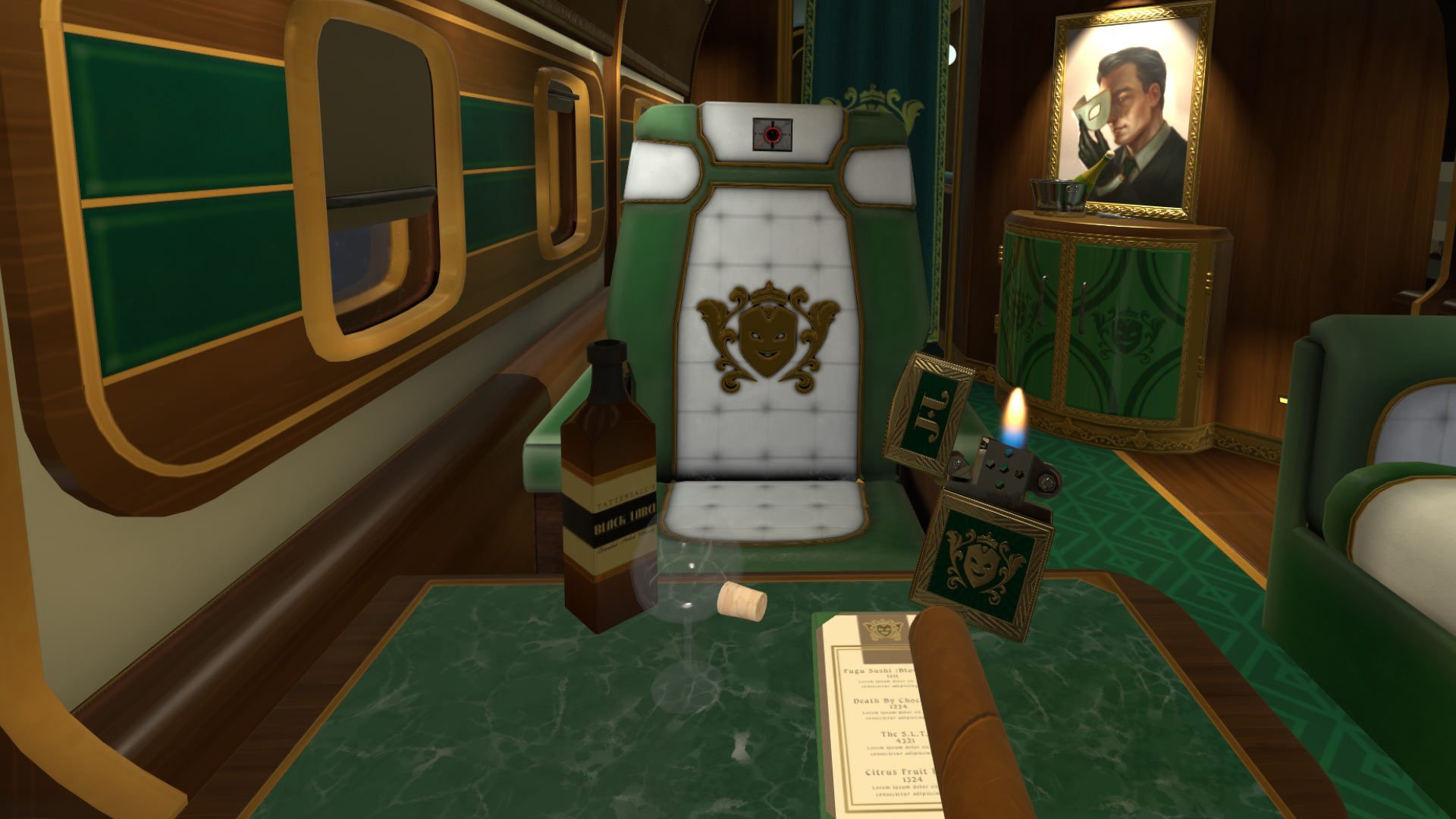
I Expect You To Die 2: The Spy and the Liar is a single-player puzzle game that, true to its name, is a direct extension of the hit spy-flavored VR puzzler launched in 2016, tasking you again to foil the evil machinations of the shadowy Zoraxis corporation. Like the first, it offers up engrossing multi-step puzzles in a surprisingly fleshed out universe that feels much larger than the half-dozen rooms the game actually serves up. Owing to its clever and intuitive puzzle design and high production value, I Expect You to Die 2 makes for a fun few hours to spend for VR newcomers and pros alike.
I Expect You to Die 2 Details:
Available On: Oculus Quest, Oculus PC, SteamVR, PlayStation VR
Price: $25
Developer: Schell Games
Release Date: August 24th, 2021
Reviewed On: Oculus Quest 2
Gameplay
I Expect You to Die 2 is a direct extension of the original, offering up six new missions out of the gate. If it’s anything like the first, you can also expect that number to grow, as Schell Games has previously released three free DLC missions for the original over the years since its launch in 2016.
In classic Bond villain fashion, Zoraxis is again trying to surreptitiously take over the world and wreaking havoc along the way by (minor spoiler) kidnapping heads of state and trying to destroy the world. You’ll find yourself in six vastly different locations, all of which are packed to the gills with deadly puzzles and contraptions.
As it is, the game’s six missions provide another smorgasbord of basic VR interactions, including everything from shooting baddies with crossbows to disarming a varied number of gadgets designed to kill you in fun and unexpected ways. Many deaths can be avoided if you think critically enough about your surroundings and physically dodge them, which means you’ll have to pay close attention to everything in the level and explore each little nook and cranny to make sure you have all the right tools and clues you’ll need to move forward.

Still, some things are just plain silly, such as exploding cigars or poisonous sandwiches, which like with every death will inevitably set you back to the beginning of the level to run through the whole spiel once again, this time armed with the knowledge of what not to do. There’s some trial and error baked into the game, and if you’re not careful that may be a big percentage of the game for you, which can be frustrating.
IEYTD 2 took me around two hours to complete all the way through, although you may spend more or less time wading through multiple deaths or hunting easter eggs, of which there are good and plenty on both accounts. Running through a mission can take as little as five minutes if you already know the path to completion, or even up to 30 minutes if you’re stumbling through multiple deaths. I felt like only a few of the puzzles were truly head-scratchers.
Every missions starts out in your home base, which this time around is a cool spy van where you receive mission details, keep tabs on your progress, and hang out with easter eggs trophies and other items you’ve come across. There’s a mini-fridge with snacks too in case you’re virtually peckish.
Back at the van a controllable radio blares at your side, providing some extra flavor to missions if you tune it the right station, or just some background music to vibe to. The fact that the van is full of stuff to play with feels much cooler than simply getting a ‘next mission’ button, and is definitely a place worth exploring in its own right. There, you’ll also find a rack full of 8-track tapes representing each mission which you load into a tape deck to either start the next level or return to a previous one.
Outside of a gauntlet of puzzle-related deaths ahead of you, throughout the game you’ll also find a number of disguises. Finding and wearing all of them unlocks a mission achievement. It’s fun to dress up and roleplay, but I really wish disguises had more relevance to the game outside of random fun.
Since you don’t have an inventory, and can’t carry anything from mission to mission, each level is essentially a self-contained bit of story that you can easily revisit. Puzzles typically only offer one set solution though, which provides little replay value. Still, its missions offer their own brand of fun, and are bite-sized enough for short play sessions if you’re running low of time or just want to pass the headset around to a friend.
In the end, I was left the answer to a burning question that I had before diving in. Does it feel like a VR game from 2016? The answer is a no with a very small yes (more in Immersion below).
Despite being very much rooted in design tropes pioneered at the beginning of the consumer VR era, I Expect You to Die 2 overall serves up a unique experience that puts accessibility at the forefront, and backloads it with intrigue, keen storytelling, and a brand of fun puzzles that consistently keeps the original in the top 20 Oculus Quest games. I expect the same will be true with the sequel, as it’s basically a substantial slice of more of what people loved about the first, but with slightly more lush interiors and more cash to shell out for celebrity voice actors and musicians.
Immersion
The world in IEYTD 2 is so well fleshed out that it’s almost a shame you’re stuck seated in one place. Everything from set pieces, in-game objects and tools, and audio design are there to draw you into the fictional world of international espionage. Even in spite of its bright and cartoony vibe, the world manages to feel truly lived in. Most levels offer enough textural contrast to make each object visually distinct, although at least on Quest 2 I found two later levels to be a bit muddy and difficult to read.
Considering the bulk of the game is based around using gadgets and defusing death machines, direct object interaction isn’t the game’s strong suit. Picking up individual items can be fiddly at times since objects sometimes snap to your hand in weird ways, making you sort of shuffle them from hand to hand to get a complete view of, say, a map that has a key instruction on the back side. Oftentimes your hands disappear completely when holding things, which could be better served with dynamic hand poses for more realism, à la Lone Echo or Echo Arena. That’s a bit of a shame since objects are often well-articulated, like being able to open a cork on a bottle and put it back or flicking open a lighter.

Instead, the game relies heavily on telekinesis to let you manipulate items or puzzle pieces. You do this by pointing your controller at the object, using selecting it with the 3D cursor by pulling the trigger, and either reeling it in closer or farther away with the thumbstick, trackpad, or button depending on your setup.
Using telekinesis isn’t as damning to immersion as you might think when it comes to object interaction since it comes part and parcel with the game’s overall design. Although far away objects can be a bit too fiddly to select at times, most levels are fairly small, sometimes no larger than a few square yards (or meters) in size. Like with the first game, you can physically pause items in mid-air to keep track of their whereabouts, which is a handy little thing when you need a screwdriver, tinsnips, fire extinguisher, and lighter all in one go.
Audio design is on point, although positional audio plays a minor role in solving or locating puzzle pieces. The game’s soundtrack is really the star of the show here, as the intriguing intro sequence puts you in another abstract Bond-style opening, performed by sad clown singer ‘Puddles Pity Party’, and the swelling background music appropriately sets the stage. Check out the two-minute opening credit sequence below to see what I mean.
Speaking of audio, one of the characters in the game is voiced by Wil Wheaton, and he isn’t there for a quick cameo either. That’s right, Star Trek TNG’s boy genius Wesley Crusher (and itinerant nerd) is a mainstay throughout the game and is an excellent voice actor in his own right, adding to the game’s professional VO cast. You don’t get to see much of anyone though, as you’re more often than not completely alone to solve puzzles.
Comfort
As with the first in the series, I Expect You to Die 2 is an entirely seated affair with almost zero artificial locomotion, save the opening credits and a single sequence when you’re being lowered down a pully system to the level below. It’s easy to play even from an office chair with armrests, as nearly all interactions are forward-facing and don’t require any weird reaching for, say, a side-mounted holster. Telekinesis definitely bridges the gaps here if you’re dead set on not shifting your weight around whilst seated to reach something physically.
This makes it essentially ideal for newcomers to VR, putting it in the same class as Job Simulator in hand-off-ability to people who may be overwhelmed with locomotion schemes, inventories, and the like.
I Expect You to Die 2 Comfort Settings – August 24th, 2021 |
|
Turning |
|
| Artificial turning |  |
| Smooth-turn | n/a |
| Adjustable speed | n/a |
| Snap-turn | n/a |
| Adjustable increments | n/a |
Movement |
|
| Artificial movement |  |
| Smooth-move | n/a |
| Adjustable speed | n/a |
| Teleport-move | n/a |
| Blinders |  |
| Adjustable strength |  |
| Head-based | n/a |
| Controller-based | n/a |
| Swappable movement hand | n/a |
Posture |
|
| Standing mode |  |
| Seated mode |  |
| Artificial crouch |  |
| Real crouch |  |
Accessibility |
|
| Subtitles |  |
| Languages | n/a |
| Alternate audio |  |
| Adjustable difficulty |  |
| Two hands required |  |
| Real crouch required |  |
| Hearing required |  |
| Adjustable player height |  |
The post ‘I Expect You to Die 2’ Review – A Worthy Sequel to VR’s Deadliest Spy Puzzler appeared first on Road to VR.
from Road to VR https://ift.tt/3Di342y
via IFTTT
No comments:
Post a Comment